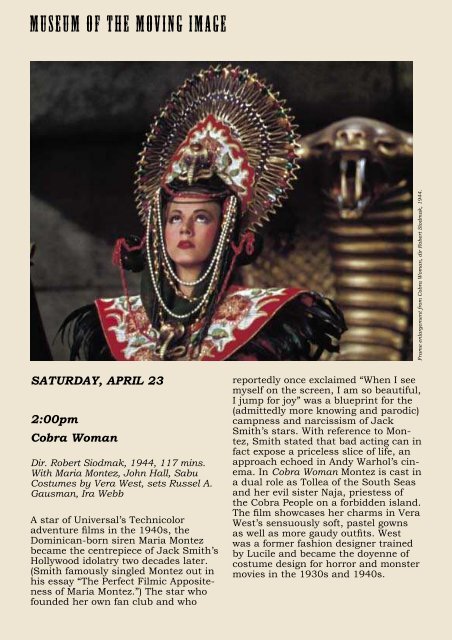Download the full program as PDF - Fashion Film Festival
Download the full program as PDF - Fashion Film Festival
Download the full program as PDF - Fashion Film Festival
Create successful ePaper yourself
Turn your PDF publications into a flip-book with our unique Google optimized e-Paper software.
MUSEUM OF THE MOVING IMAGE<br />
sAturDAY, April 23<br />
2:00pm<br />
cobra Woman<br />
Dir. Robert Siodmak, 1944, 117 mins.<br />
With Maria Montez, John Hall, Sabu<br />
Costumes by Vera West, sets Russel A.<br />
Gausman, Ira Webb<br />
A star of Universal’s Technicolor<br />
adventure films in <strong>the</strong> 1940s, <strong>the</strong><br />
Dominican-born siren Maria Montez<br />
became <strong>the</strong> centrepiece of Jack Smith’s<br />
Hollywood idolatry two decades later.<br />
(Smith famously singled Montez out in<br />
his essay “The Perfect <strong>Film</strong>ic Appositeness<br />
of Maria Montez.”) The star who<br />
founded her own fan club and who<br />
reportedly once exclaimed “When I see<br />
myself on <strong>the</strong> screen, I am so beautiful,<br />
I jump for joy” w<strong>as</strong> a blueprint for <strong>the</strong><br />
(admittedly more knowing and parodic)<br />
campness and narcissism of Jack<br />
Smith’s stars. With reference to Montez,<br />
Smith stated that bad acting can in<br />
fact expose a priceless slice of life, an<br />
approach echoed in Andy Warhol’s cinema.<br />
In Cobra Woman Montez is c<strong>as</strong>t in<br />
a dual role <strong>as</strong> Tollea of <strong>the</strong> South Se<strong>as</strong><br />
and her evil sister Naja, priestess of<br />
<strong>the</strong> Cobra People on a forbidden island.<br />
The film showc<strong>as</strong>es her charms in Vera<br />
West’s sensuously soft, p<strong>as</strong>tel gowns<br />
<strong>as</strong> well <strong>as</strong> more gaudy outfits. West<br />
w<strong>as</strong> a former f<strong>as</strong>hion designer trained<br />
by Lucile and became <strong>the</strong> doyenne of<br />
costume design for horror and monster<br />
movies in <strong>the</strong> 1930s and 1940s.<br />
Frame enlargement from Cobra Woman, dir Robert Siodmak, 1944.<br />
4:30pm<br />
Flaming creatures<br />
and sensuous ple<strong>as</strong>ures<br />
Total running time 55 mins.<br />
Flaming creatures<br />
Dir. Jack Smith, 1963, 43 mins.<br />
With Francis Francine, Sheila Bick, Mario<br />
Montez, Joel Markman<br />
Costumes by Jack Smith and actors<br />
Flaming Creatures, dir Jack Smith, 1963. Courtesy<br />
of F<strong>as</strong>hion in <strong>Film</strong> <strong>Festival</strong> and The <strong>Film</strong>-Makers’ Cooperative.<br />
Deemed obscene by New York State,<br />
Smith’s revolutionary Flaming Creatures<br />
is an elusive m<strong>as</strong>terpiece which<br />
continues to f<strong>as</strong>cinate. Shot in blackand-white<br />
on outdated film stock,<br />
it reproduces some of <strong>the</strong> sensuous<br />
ple<strong>as</strong>ures and high glamor from Hollywood’s<br />
golden days, especially referencing<br />
such stars <strong>as</strong> Marlene Dietrich and<br />
Smith’s beloved Maria Montez. He gives<br />
his cross-dressed actors <strong>the</strong> freedom<br />
to preen, dance, and play<strong>full</strong>y inhabit<br />
<strong>the</strong> rapturous and exotic fant<strong>as</strong>ies of<br />
Hollywood cinema. Through a combination<br />
of fant<strong>as</strong>tic tableau-vivant compositions<br />
and cinéma vérité camerawork,<br />
Smith brilliantly transforms his b<strong>as</strong>ic<br />
set and thrift store ‘couture’ into a dazzling,<br />
Sternberg-like mise-en-scène.<br />
<strong>the</strong> most Wonderful Fans<br />
of <strong>the</strong> World<br />
(De mooiste waaiers ter wereld)<br />
Dir. unknown, 1927, Ne<strong>the</strong>rlands/<br />
France, 12 mins.<br />
With Pépa Bonafé; Komarova, Korgine,<br />
Sergine; John Tiller Follies Stars<br />
This is a luxuriously stencilled short<br />
film shot in France and distributed<br />
in <strong>the</strong> Ne<strong>the</strong>rlands in 1927. Like <strong>the</strong><br />
better-known <strong>full</strong>-feature La Revue des<br />
revues, it w<strong>as</strong> filmed on <strong>the</strong> stage of a<br />
Parisian music hall, only this time it is<br />
considerably snappier and presented<br />
without an over-arching narrative<br />
framework. The film includes Orientalist<br />
numbers such <strong>as</strong> “In <strong>the</strong> Temple of<br />
<strong>the</strong> Fakirs” and “The Chinese Fan” and<br />
makes great use of close-ups.<br />
7:00pm<br />
Drag glamour<br />
total running time 95 mins.<br />
Frame enlargement from The Most Wonderful Fans<br />
of <strong>the</strong> World, dir unknown, 1927. Courtesy EYE <strong>Film</strong><br />
Institute Ne<strong>the</strong>rlands<br />
This <strong>program</strong> pairs Jose Rodriguez-<br />
Soltero’s lavish Lupe with Ron Rice’s<br />
landmark psychedelic m<strong>as</strong>terpiece<br />
Chumlum. It features two of <strong>the</strong> most<br />
accomplished uses of superimposition<br />
in underground film, transporting drag<br />
glamor into a psychedelic, cubist-like<br />
dimension.


